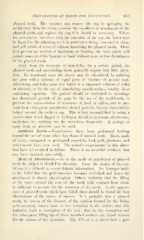Page 655 - My FlipBook
P. 655
PREPARATION OF TEETH FOR PLANTATION. 653
planted tooth. The operator can remove the cap by springing the
metal away from the teeth, examine the condition of attachment of the
planted tooth, and replace the cap if it should be necessary. Where
the articulation interferes with the retention of the cap, the latter may
be ligatetl to the adjoining teeth in addition to being cemented to them,
and still admit of removal without disturbing the planted tooth. There
js'at present no method of ligaturing or banding the teeth which will
permit removal of the ligature or band without more or less disturbance
•of the planted tooth.
Aside from the necessity of immobility for a certain period, the
planted tooth and surrounding tissue generally require but little atten-
tion. In occasional cases the tissues may be stimulated, by painting
the gum with a mixture of equal parts of tincture of aconite root,
chloroform, and iodin paint (the latter is a saturated solution of iodin
in alcohol), or by the use of stimulating mt)uth-washes, notably those
containing capsicum. The patient should be cautioned to encourage
the downward growth of the gum by the use of the toothbrush, to
prevent the accumulation of remnants of food or saliva, and to pre-
vent their subsequent putrefaction should particles become unavoidably
lodged around the tooth or cap. This is best accomplished by using a
camel's-hair brush dipped in hydrogen dioxid or pyrozone, electrozone,
meditrina, etc., washing out the interstices frequently. A syringe or
spray from an atomizer may be used.
Artificial Roots.—Experiments have been performed looking
toward the use of roots other than those of natural teeth. Roots made
of ivory, corrugated or perforated porcelain, lead, gold, platinum, and
other metals have been used. The writer's experiments in this direc-
tion have all resulted in failure. There is no recorded evidence that
any have residted successfully.
Mode of Attachment.—As to the mode of attachment of planted
teeth the subject is clouded in obscurity. From the nature of the con-
ditions it is difficult to secure definite information. Dr. Younger holds
to the belief that the pericementum becomes revivified and hence the
attachment is almost physiological. Others maintain that the filling
of the space around the root of the tooth wdth compact bone tissue
is sufficient to account for the retention of the tooth. In the appear-
ance of planted teeth which have failed there should be found the best
illustrations of the causes of success. It is ])robable that a planted
tooth, by reason of the absence of the cushion fi)rmed by the living
pericementum, causes more or less irritation in the socket; that this
irritation leads to resorption of the root ; that in this resorption and
the subsequent filling up of these resorbed surfaces are found reasons
for the success of the operation. Fig. 579, at a, a, shows how a par-


